на
главную
XI. Art
| |
|
Decoration of Bags and Baskets |
707
|
| Decoration
of Rugs made of Reindeer-Skins. |
7I2 |
| Drawings |
723
|
| Writing |
727
|
| Geographical
Maps |
732
|
707
JOCHELSON,
THE KORYAK.
Decoration
of Bags and Baskets. The ornamentation of basketry
depends upon the technique that is applied. The simplest form of basket-
decoration
is that found in open twining.1 In all work of this kind the
decoration
is brought about by inserting colored warp-strands (see Figs. 228,
229,
c). Various effects are produced by the different grouping of the colored
strands.
This type
of decoration
is found
both on grass bags and
nettle-
1 See
p. 634.
708
JOCHELSON, THE
KORYAK.
fibre bags. Another type of decoration that is
applied in this technique is
produced by the insertion of tassels made of dyed hair of young seal, or of
crewel.
The single bunch of hair or the single piece of crewel is caught in
|
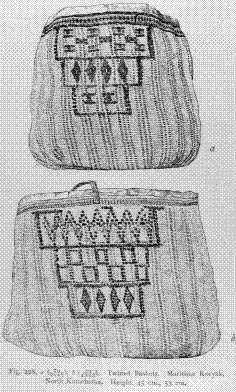
|
the twined stitch in the
manner
indicated on p.
680. The designs
made
by these tassels
are
quite analogous to
those applied to
clothing, which were described
before (see Figs. 210
and 225). The widerectangle on the bag
shown in Fig. 228, a,
for instance, is made of
tassels of seal-hair dyed red, and of red, light
blue, and dark blue
crewel, which form chec- keredrectangles like
those found on the em-broidered strips of the
funeral coat shown in
Fig. 225. The designs
found on the ornament-
ed rectangles on Fig.
228, b, form in the top
row a zigzag band like
that shown in Fig. 209;
and below this, checker-
work similar to the
checker-work found on so many of the
coats. It
seems that the most |
|
Fig. 228. Twined Baskets.
Maritime Koryak, North Kamchatka. Height, 45 cm., 53 cm. |
|
typical method of applying the tassel-ornament is in
the form of a series of
rectangles,
decreasing in size from above downward (see Fig. 228). In a few
cases the tassels are distributed at regular intervals over the face of the bag.
This
kind of decoration is found only on the front of the bag. In a few speci-
mens
the tassel decoration is also found on close-twined weaving (Fig. 229, a, b). The
designs found in close-twined weaving are quite different from those
found
in open-twined weaving. The two bags shown in Fig. 228
and a third
one in Fig. 229,
c, illustrate
specimens in which the body of the bag is made
709
JOCHELSON,
THE KORYAK.
in open-twined weave, while the
upper border is made in close-twined weave.
In the latter the color effects are brought about by using undyed and dyed
woof-strands. In many cases the designs found in this kind of weave
recall
strongly the slit-embroidery designs which were described before. Thus
the
design found on the upper border in Fig. 228, a, is similar in
type to part
of the strip shown in
Fig. 206,
or to the second row in Fig.
207. The top
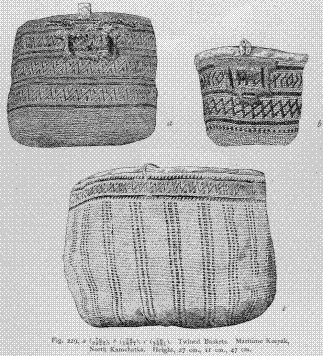
Fig.
229. a,b,c Twined Baskets. Maritime Koryak, North Kamchatka. Height, 27 cm.,
11 cm., 47 cm.
row shown in Fig. 162,
a, has the same form as the top row in Fig. 207,
while the lower rows correspond to the common bar design, which is brought
about either by slit-embroidery or by caught-in strips, as in Fig. 210.
In
Fig. 163 the analogy is even closer, in so far that the rhythmic alternation
of the width of the white squares is quite similar to the rhythmic
arrangement
found in the slit-embroidery.
Thus, in the four upper bands of square designs,
710
JOCHELSON, THE KORYAK.
which are each seven stitches wide, we find the
following arrangement. The
two
outer lines are throughout black; and in the three inner lines the fol-
lowing
arrangement of colors is repeated: I black,
I white, I black, 2 white,
2
black, 2 white, 2 black, 2 white. The two lowest bands of square designs
have
a regular alternation of 2 white
and 2
black.
Ouite
a different type is represented by curiously asymmetrical zigzags,
which
are shown on the border of Fig. 228, b, in Figs. 229 a and 163. While
the
zigzags may be related to the zigzags found on clothing, the peculiar
arrangement
of the design seems to be typical of twined basketry.1 It is not
impossible
that in its origin it is related to the triangular border designs
surrounding the embroidered strips of clothing (see, for instance, Fig. 212).
In
Fig. 228, b, the zigzag is shown in its simplest form. In Fig. 229, a and
c, and even more in Fig. 163, the same zigzag appears enlarged, and
with
small triangles inserted in the larger zigzag.
The
border of Fig. 229, c, has above and below a series of standing
and
hanging triangles quite similar to those found in the embroidered strips
of
clothing; and the whole arrangement may perhaps be compared to the band
of applique embroidery shown in Fig. 208. The standing triangles are
also
used independently, being arranged in single or double rows.
Another
type of decoration which is used in close-twined weaving consists in the application of cross-zigzags which form rhomboidal designs
(see
Fig.
162
b, c, and Fig. 229 b). In the top row of Fig. 229, b, we also
have
a series of diamonds surrounded each by two angles the sides of which
run
parallel to the sides of the central rhomb.
Attention
may also be called to the decoration at the lower part of the
basket
shown in Fig. 163, where alternating rows of varying widths of ver-
tical
black and white lines, and of diagonal black and white lines, occur.
The
ornamental designs on coiled basketry are also similar to the designs
used in slit-embroidery. Four distinct methods are employed in producing
ornamental
effects on coiled baskets. Narrow strips of black, occupying a
small
portion of a single coil, or forming vertical bands consisting of pieces of
black occurring in a series of coils, are made by using material which is dyed black for whipping the coils. The black
checker-work shown in Fig.
230, a, and the vertical stripes shown in Fig. 230, b, are made in
this
manner.
A similar technique is used in the well-made basket shown in Fig.
231.
Here the design is made by using dyed
nettle-fibre instead of grass
for whipping the coils. The method
differs from the preceding in so far as
in the
checker-work the nettle-thread
is carried
on continuously, and the
1 A quite analogous design on twined baskets from Ruanda, in
East Africa, shows very clearly that the
asymmetrical form of these zigzags is a result of the technique of
twining. These African baskets are also very
closely woven, and exhibit almost exactly the same design as the Koryak
baskets (see collections of the Berlin
Ethnographical Museum, Cat. No. III E, 6989).---
Ed.
711
JOCHELSON,
THE KORYAK.
whipping
is merely arranged on the outside in such a way that two successive lines of nettle-thread are followed by two successive lines of grass
whip-
ping. Horizontal
bands, such
as are shown in
Figs. 230 and 232, are
made
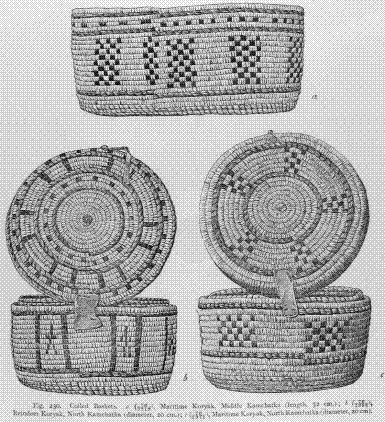
Fig.230.
Coiled Baskets. a, Maritime Koryak, Middle Kamchatka (length, 32 cm.,); b,
Reindeer Koryak, North Kamchatka (diameter, 20 cm.); c, Maritime Koryak, North
Kamchatka (diameter, 20 cm).
in a different manner. A grass coil
is inserted, which is overlaid on the
outside with one continuous strip of grass which is dyed black. This coil
is not whipped by the close stitch, like the other coils of the basket, but
is sewed to the preceding coil by a very loose stitch made of nettle-thread
dyed
90
JESUP NORTH PACIFIC EXPED., VOL.
VI, PART
2.
712
JOCHELSON,
THE KORYAK.
black.
This stitch
is identical
with the
stitch employed in the bottoms
of baskets.
A fourth
method is applied in a few
Kamchadal baskets; horizontal bands
being made
by overlaying an ordinary
whipped coil with grass dyed red,
or with
red, blue,
or black
strips of cloth.
This is held in place by passing
every third
or fourth
stitch over the strip,
which is thus woven on the
coil (see
Fig. 233).
Various forms
of checker-work, zigzag bands, and
rectangles,
are the
principal figures
that are
found. The
covers of round baskets
often bear
designs forming
rosettes. In
one basket Fig. 230,
b), figures
are found which evidently represent
human beings.
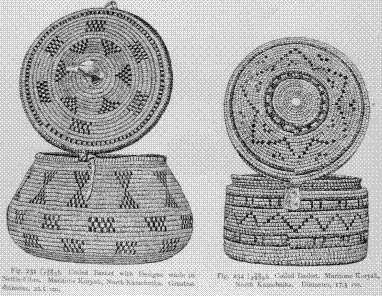
Fig.
231. Coiled Basket with Designs made in Nettle-Fibre.
Maritime Koryak, North Kamchatka. Greatest diameter, 22.5 cm
Fig.
232. Coiled Basket. Maritime Koryak, North Kamchatka.
Diameters, 17.5 cm.
Decoration
of Rugs made of Reindeer-Skins. It is doubtful whether
this
art was developed among the Koryak women previous to their contact
with
the Russians. At present it has developed into a domestic industry.
Koryak
fur rugs are carried by traders far and wide. They may be seen on
the
walls or floors and among the furniture of Russians living at Petropavlovsk,
Okhotsk,
Yakutsk, and Vladivostok. In Irkutsk their price is ten times as
high
as at home. Among the rich Yakut, Koryak rugs of fine workmanship,
made of skins of young reindeer, sometimes take the place of the crude rugs
of
Yakut production made of cow or horse hides.
713
JOCHELSON,
THE KORYAK.
In
every village of Maritime Koryak on Penshina Bay, I found the women
at work on rugs during the winter, but only
once did I see a rug used by
the Koryak themselves as an ornament
in the house. It covered the platform
which served as a sleeping-place for
guests. Evidently this industry has
developed as a result of Russian demand.
To a great extent this is also
true of embroidered coats. Every
Russian or Yakut merchant, or official in
the Maritime or Yakut provinces, if he has to travel on private or official
business, buys an embroidered coat of
reindeer-skins of Koryak manufacture.
It is seldom that the Koryak
themselves wear embroidered coats. They are
worn only by Koryak traders. Women
wear embroidered dresses more fre-
quently than men.
I speak here of every-day
clothing, and not of festival,
|
dancing, or funeral garments, which are always
embroidered. The making of rugs has
principally developed
among the Koryak of Penshina Bay. They find competitors,
especially in silk embroideries, among
the Russian-
ized Koryak women of the Yamsk
settlement.
The Russianized Yukaghir and Chuvantzy
women on the Anadyr River and on the
lower course of the Kolyma River also enjoy
quitea reputation for their art of
ornamenting fur
dresses and making rugs. The
Russianized
native women of the Kolyma, however,
are
less skilful than those of the Anadyr.
In
decorating fur rugs, colored thread and
silk or bead
embroideries are not used. Small
pieces of the white and of the black fur of young reindeer
sewed together are the
only
material used for
the ornamentation.
The
|
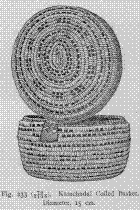
|
|
Fig. 233 Kamchadal Coiled
Basket. Diameter, 15 cm. |
comparatively cheap fur of young reindeer
with its thick, soft, and glossy
hair
matches in beauty the expensive furs, and is less valuable only on account of its lack of durability, since the hair usually falls out soon, as in
dresses of reindeer-skin. Rugs, however, last longer. Since the entire beauty
of
a rug is in its ornamentation, it is almost wholly made up of the pieces
of
white and of black fur which form the ornamental figures. A Koryak girl
will
work all winter on a rug, if it is a large one, in order to exchange it
with
a merchant for cloth, calico, ornaments, or food-products. The rugs are
either
square or of elongated rectangular form. Their length varies from one
metre
to three metres. As in dress-decoration, the regular designs are geomet-
rical
forms, animals, conventionalized plants, or a mixture of all these forms.
The
rugs here illustrated were made in the villages of Paren, Kuel, Mikino,
and Kamenskoye.
714
JOCHELSOX,
THE KORYAK.
Fig. 234 represents a large ornamented rug, the principal designs of
which
are familiar to us from the decoration of funeral dress. It is intended
to
be symmetrical around the central vertical row of squares. The upper four horizontal
rows are perfectly symmetrical. Numbering the rows as indicated
on
the figure, it seems probable that 10 e and 9 f have
been exchanged by
mistake,
because with this change the following lines would also be symmet-
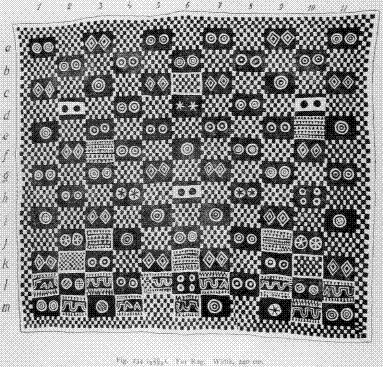
Fig.234.
Fur Rug. Width, 240 cm.
rical. Considering all circles, and all other
squares exhibiting the same type,
as
equivalent, the only other irregularity appears in the bottom row, where 5
m
ought to have been a circle design, in order to correspond to the
rest
01
the arrangement. Some of the circles have strips of dyed skin instead of
dark
fur. These are particularly the four corner squares (I a, m; II,
a, m); I, e, i; 3,
c, g; 6, b, f, j; 7 m; 9, c, g; II, e, i. Certain indications of
regularity
may be noticed in the
use of the framed checker designs 2 k, 3 j,
715
JOCHELSON,
THE KORYAK.
9 j, 10
k, and
in the
tendency to alternate angular and round designs in rows
5 and
7 ; in
the exclusive
use of round designs in rows 4 and 8;
and in
the repetition of angular designs
in every fourth place in rows 1, 3,
9, 11. Attention
may also be called to the occurrence of the curvilinear plant-design in
the two
lowest rows, which do not
appear in other parts of the rug.
It may
also be noticed that there is a tendency, which may be observed in other specimens
as well, to repeat the same design
in white on a black background, offsetting
the same
design in dark
on a white background.
Thus 6
d must be
considered equivalent to 4 h
and 8 h and to 2 j and
10 j; and the black circles
6 h
and 2
d and 10
d are equivalent to
the white
circles on a dark background.
On the
whole, the impression conveyed by the rug is that of a
definitely planned repetition of designs, without, however, attaining to such unity
of plan as would result in a clear pattern.
In certain respects another rug
is similar to the one just described.
It
also consists of a large checker-work, alternate squares of which consist of
|
small checker-work. Here we find on
the
dark fields a single conventionalized
curved
leaf; but a different design is
shown
in the top row and in the bot-tom
row, consisting of a four-pointed
star,
the centre of which is a four-
leaved
flower from which branches
extend,
dividing at their ends into
two
leaves. The same design is re-
peated
on the extreme right and left
field
of the second row from the bottom.
This
similarity of corresponding fields
occurs
in a number of rugs.
Fig.
235 represents part of a rug,
the
ornamentation of which consists of
crosses
made up of white rhombi on
black background. This cross, in
my
opinion, was adopted from Russian
|
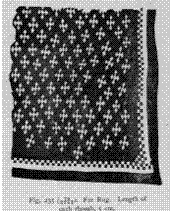
|
|
Fig. 235. (70/3269). Fur
Rug. Length of each rhomb, 5 cm. |
designs. The borders of the rug are trimmed with
three strips of fur,
the
innermost one covered with the checker-ornament; the second, of solid
white
color; and the third, black. In one part of the rug the rhombi are
set
into solid skin. This portion of the rug is somewhat irregular. In other
parts
the pattern is made up of long strips of dark skin alternating with
strips
of mosaic work consisting of checkered rhombi and of large rhombi of
dark
skin. In this part of the rug the arrangement of the rhombi in the
direction
parallel to the long strips is quite regular, while the arrangement
in the direction of the other diagonal is not so regular.
716
JOCHELSON, THE
KORYAK.
Fig.
236 represents
a small square rug,
elegantly and beautifully made, with
pictographic ornaments in the centre.
The same group a man sitting in
a sleigh drawn by two
white reindeer and a black one
is represented in
the upper
and the
lower rows. The
hind reindeer is evidently drawing the
sleigh, although the sleigh and the
man are too small in comparison with the
reindeer. The
second and
third rows
from the
bottom represent two wolves
pursuing two
reindeer. In
the lower row the group is
made up of white
silhouettes of animals, while in the upper row they are dark. The white animals
are sewed
to squares
of dark
skin, which
are set
into the
rug. The
same is done with the white sledge in the left-hand lower corner.
The reindeer
can be
distin-
|
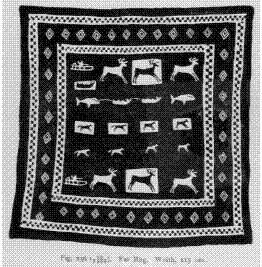
|
guished from the wolves
by the absence of the
tail and by the hoofs,
which are clearly seen
in spite of the smallness
of the figures. The rein
deer have no antlers.
These are evidently ei-
ther reindeer in spring,
or fawns. The latter
seems to be the more
likely, since the reindeer
are shown of the same
size as the wolves. Al-
though the polar wolves
are very large, yet they
are smaller than full- grown reindeer. The
wolves are recognized
by their straight, thick
tails. Dogs,
when pur-
|
|
Fig. 236. Fur Rug. Width,
115 cm. |
|
suing wild animals, turn their tails upward. Owing to a
lack of knowledge
of
perspective on the part of the women artists, all the running animals are
placed
in one line, which deprives the wolves in the hunting-scenes of realism
and
vividness. Somewhat more vivid is the scene in which two skin boats are
towing a captured whale, but that is because as a matter of fact these
objects
usually form one line. The wound of the whale is indicated by a
small
tuft of red yarn, which appears in the illustration as a black speck near
the
tail end. The whale on the right is evidently placed there to fill up the
black
background, and the same may be said of the skin boat in the left-hand
corner above the whale.
717
JOCHELSON,
THE KORYAK.
Another
rug has
a central field
similar to
that of the one just
described.
The figures on
the two rugs look
so much alike that they seem
to
be cut
from the
same pattern.
There are in the middle the same two reindeer
pursued by
a single
wolf, the
lower row
black on a white back-
ground, the upper white on
a dark background; but the
background in this
case is
set off
from the whole rug by a narrow white
strip surrounding the
rectangle
in which
the white
animal figures are inserted.
These two rows
occupy the centre of the
middle field.
Under it there are two dark reindeer
on
a white
background, of the same
type as those in
the right-hand
upper
corner of Fig.
236;
between them,
the sledge-driver shown in the
left-hand
upper corner of
Fig. 236
in dark
on a white background.
The boat under his driver
is repeated
in white
near the lower border
of the central field,
pursuing the whale in
white, which
is shown at the
right-hand end of the
second
row in
Fig. 236.
This same design is repeated in dark on a white
background in the top row.
The second row from the top
contains designs
not found in Fig. 236.
On the right and left there are two flowers, the
one
on the
left dark on
white, the one on the right
the reverse. Between
them is a
dark lion on
a white rectangle.
This central field is surrounded
by
an inner rectangle
consisting of a single row of black and white squares
between two white
lines. To
the dark
border-field in
Fig. 236,
with its
rhombi, corresponds a similar border-field in which there are a series of whitevines. In
the middle on top the
figure of the lion is repeated in white on
a
dark background. This
is surrounded by a white strip of the same width
as the dark stripe,
in which the same designs are repeated in dark, except
that the
lower corners
contain twice
a design shown in
Fig. 203, c,
while
the
two upper
corners are occupied
by a conventionalized leaf like the one shown in Fig. 213,
under which is repeated the same design which is found in the
lower corners.
This specimen
is interesting in comparison with the
other
specimens here
described, because it shows that the same stereotyped
patterns are used
in a variety of combinations.
An
animal-ornament similar to that shown in Fig. 237 is pictured in one
of
the central fields of another rug. The whole rug consists of large checkers
of
dark and white fur. Its width equals that of forty-three of the small
squares
(220 cm.), and its length is the same. A border of nine rows of
small
squares surrounds the middle field on all sides. In this field four squares
of
dark skin, each equal to eleven checker units in length, are inserted,
thus
leaving a row of three checker units up and down and from right to
left,
separating the four squares. On the upper left-hand square a tent is
represented,
and on each side four sledges, one of which is held by one
man,
while another man sits on it. The lower left-hand square is decorated
with
repetitions of two stars, three seals, and four birds. The right-hand
lower
square has
a plant-design
similar to
those on
the outer
border of
718
JOCHELSON, THE
KORYAK.
Figs. 239 and 240. On the upper right-hand square
(Fig. 237) are a number
of
animal designs. The animals and the man represent a reindeer-herd
followed
by their herdsman; but, in the absence of perspective, this impres-
sion
is not produced, the animals being represented one above another in a
vertical
plane. An interesting feature in this design is the smallness of the
figure
of the herdsman, who is more distant than the reindeer, which suggests
some conception of perspective; and also the tracks of the reindeer-hoof, which
are
represented by white pieces of fur sewed in.
Fig. 238
represents an
entire fur rug with a mixed ornament. Besides
men, the animals represented
here are dogs, seals,
flying geese, some flying
|
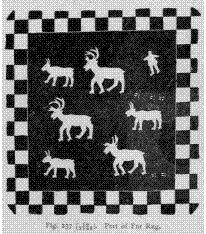
|
bird in the form of a cross (in the
corners
of the middle square), and
a
lobster-like animal in the inner
square.
On the white back of the
latter is shown a
conventionalized
figure, in black fur, of what may be
an animal or a plant, the same that
I have seen on Russian printed cal- ico. The
figure is also found sepa- rately, of white fur on a black
back-
ground, in the space between the
two inner squares. None of the figures of the rug have any relation
to one another, and even the same
order in their arrangement is not
always observed. Deserving special attention among
the figures are
two white ice-floes in the form of rhombi, on which
black seals are
|
|
Fig. 237. Part of
Fur Rug. |
|
resting.
Near the lower right-hand corner is a man in a skin boat, with small
oars
tied to the sides, such as are used in
Penshina Bay.1
The
checkered border setting off the middle square is made of alternate
diagonal
rows of dark fur, white fur, and reindeer-skin dyed reddish brown. On
the right-hand side these diagonals run regularly in the order brown skin, white,
dark, white fur, from the right-hand side below to the left-hand side
above.
On the left-hand border they also run quite regularly, so that the
dyed
skin runs diagonally from the left side below to the right side above.
On
the left-hand border the diagonals of dyed skin run zigzag, but so that
every
third diagonal is interrupted by a square of dark fur. In this waya
pattern results which consists of half-diagonal squares alternately turning to
1 See
p. 539.
719
JOCHELSON,
THE KORYAK.
the left and to the right. On the upper and lower
border the arrangement
of
diagonals and these half-diagonal squares are irregularly arranged. Most
of the circles and
rhombi are made of white and dark fur. The four groups of
corner circles have, in place of the dark fur,
dyed skin. The outer dark
rings of the eight circles in the
upper row are made of the same material.
In the border containing the
plant-ornament, the second circle from below,
right and left, is' made in the same
way, as are also the four circles in the
innermost square.
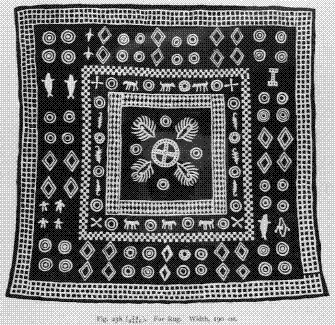
Fig.
238. (70/3446). Fur Rug. Width, 190 cm.
Of
a similar mixed character is the ornament of the rug shown in
Fig.
239. Especially interesting in this ornament are the conventionalized
plants,
which are not represented as silhouettes, but have their interior parts
also
worked out.
The
bulk of this rug is made of white and dark reindeer-skin; but the
insets
of fine checker-work on the right and left are made of dark and light
fur,
and also
of stripes of brown
skin, which give the patterns that appear
91Jesup
north pacific exfed., vol. vi, part 2.
720
JOCHELSON, THE KORYAK.
distinctly
in the
illustration. The
arrangement is
such that
in every
case the
bare skin takes the place of white pieces,
excepting in a few spots
along the
upper and
lower borders
of the designs. In
the second strip from the top
on the right-hand side of the rug, about
halfway between the three dark strips on
the right side and the inner
square, there are two vertical lines
of brown
rhombi inserted
in place
of the dark fur
patches. These
do not appear
in the illustration, because the
difference between the dark fur and the brownish
skin is too slight. Stripes of light reddish-brown skin are
also used
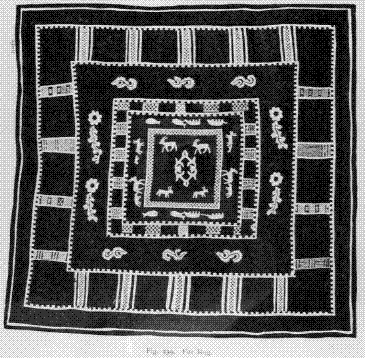
Fig.
239. Fur Rug.
in
the four
patches on
the lateral
borders surrounding
the animal
figures.
These appear in the cut of somewhat lighter
color than the adjoining stripes of
dark fur.
Still
better, and
indicative of
greater skill, is the
work represented
by
the plant-ornament on
the rug
shown in
Fig. 240,
especially the wreath in
721
JOCHELSON,
THE KORYAK.
the
centre.
Looking at this delicate and elaborate
design, one would hardly
imagine that it was
made of a fur mosaic sewed together
with sinew-thread:
it looks
more like
a drawing sketched with
a flexible brush.
Inside of the
wreath we
find the figure of a Tungus
astride a reindeer. The execution of the figures of the animal and the rider
is wonderfully true to life.
I suppose
that the
human figure
does not represent an adult Tungus, or
it would be
considerably larger.
It should
be noted
that the
ornamentation of his cap
and of
his cut-away coat,
as well as that on
his apron, boots, and
trousers,
and also
the tongue
of the
reindeer, are
done in
colored yarn.
It is the
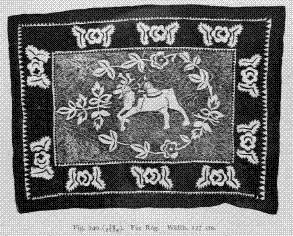
Fig.
240. (70/2728). Fug Rug. Width, 127 cm.
only rug that 1 have ever seen
embroidered with yarn. A few leaves of the
flowers which appear in outline in the illustration are set in, being made of
pieces of skin of the same color as the background of the
rug.
Almost
all the rugs have their patterns arranged in such a way that one
definite side must be considered as the lower side, around which the
arrangement of patterns is fairly symmetrical. This feature may be
observed
in the arrangement of the patterns in Fig. 234, 236-238, 240. It may also
be noticed in specimen. Here the middle is occupied by a double circle,
somewhat irregular in form, the centre of which is occupied by a cross of
leaves similar to design 1 in
Fig. 212,
and surrounded by a ring of eight
leaf-designs similar to the design in Fig. 213.
The border of this rug is
formed above and below of four rectangular patches with diamond designs
(Fig. 241)
alternating with five
patches of dark skin of the
same form and
722
JOCHELSON, THE
KORYAK.
size.
On the
sides the
same designs
occur as the top and bottom design,
repeating
in this
way the
feature which
is of
common occurrence, that in
checker
designs in which the rectangular or square patterns run on a smooth
background
in diagonal
rows, the same
patterns occur at the extreme fields
of the horizontal
and vertical
rows. The
vertical rows of this rug contain
five rectangles with patterns
alternating with six smooth dark rectangles.
Ac-
cording
to what was said before, the uppermost and lowest of these rectangles
are
the same
as those
of the horizontal rows.
The two following patterns contain
the same rhombi, somewhat coarser, and instead of the edge consisting
of
triangles
and rhombi, an
upper edge consisting of alternate dark and white
squares,
and a lower edge consisting of the same design over a straight white
|
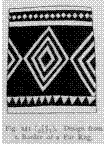
|
line. The central pattern on each side is
asymmetrical,
and
consists of the pattern just described, over which
the
upper half of the same pattern is placed, containing
the
upper half of the coarse central rhombi and the
upper
line of squares. Thus it will be seen that the
whole
design is symmetrically arranged right and left,
with
the exception of some irregularities in the central
circle.
The symmetry of the border is broken, on the
one hand by the asymmetry of the central design, on
the
other hand by the fact that all the patterns have
clearly
a heavier lower side and a lighter upper side,
all
the patterns
in the
upper and
lower half being placed
in the same direction.
|
| Fig. 241. Design from a
Border of a Fug Rug. |
|
A
square rug consisting of a central field with a star-like
flower
design made up of four trees with roots occupying the diagonals, the roots
towards the centre, and four spiral branches (two white on black, one
black
on white, and one leaf design similar to the one shown in Fig. 213,
occupying
the middle of the sides of the square has three borders con-
sisting of alternate dark squares and design squares. In the innermost row
the
pattern consists of squares containing a checker of nine smaller squares.
Each
side is divided into thirteen fields. The middle row consists of a similar
alternation
of squares, each pattern square consisting of a checker-work of
twenty-five
small squares. The interesting feature in this row is that the
sequence
of these fields is not quite regular. There are sixteen or seventeen
fields
to each side. The sixth field from the left on the upper side, which
normally
should contain checker-work, has the figure of a long-tailed quad-
ruped
sewed in. The following square to the right is the regular checker square,
which is followed by one of the regular dark squares with a white mammal
sewed in. The third square from the right in the upper row is made
up of rhombi instead of squares. The second square from the right
in
the lower
row contains
figures of two
swimming cormorants, resembling
723
JOCHELSON,
THE KORYAK.
very
much, in shape, Fig. 177,
a. The outer row contains again the coarser
checker-work of the same size as the inner row. Here a number of animal
figures are inserted on dark fields. On the left-hand side on the lower
border
of the rug we find one man holding a drum, and another man apparently-
holding a club. On the left-hand side on the upper border we find a large
and a small mountain-sheep on one field; while on the right-hand side
there
are a number of small figures set into one field, apparently representing
a flying bird, a man, and two bears. It is worth remarking that these
latter have their feet towards the left, the only case in which figures of
animals
inserted into rugs in this way do not stand upright. It should be
mentioned,
however, that
the man
in this figure
does stand upright.
|
Another
rug which illustrates the
character of the symmetry which under-
lies the rug designs is illustrated in
Fig. 242. Attention may be called to
the occurrence of the triangular design in the upper border as compared with
the square design in the lower border;
to the continuation of the lateral strips
downward; and to the finish on both
sides by a series of broad rectangles having one additional row of small squares on each side. It will be seen
from this that clearly the underlying
thought is not that of a series of white
crossing diagonals, but the maker had
rather in mind the alternation of the
larger rectangles, one consisting of
dark skin; the next, of a checker of
nine dark and white squares. In this
way the
rug was made.
The corner |
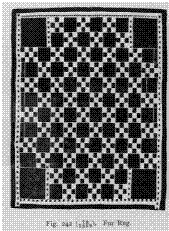
|
|
Fig. 242. (70/3869). Fur
Rug. |
pieces are all made
of a single piece, and some of the
dark rectangles along
the right and left border are also made of single pieces
of skin.
Drawings.
The Koryak use colors more often in decorative
art than in articles of sculpture. Wood-carvings are frequently colored black,
more
seldom red or brown. Engravings on bone carvings are also filled with
black
paint, and on wooden masks1 the beard is also indicated by means of black
paint, while red ochre or blood is used to redden the cheeks of masks. I
have
spoken above2 of
the use of dyes in manufactured articles and in technical
work; the decoration of skin dress by means of stamps has also been
mentioned
1 See Part I, pp. 83, 84.
2 See p. 628.
724
JOCHELSON, THE KORYAK.
in
this chapter.
The art
of drawing in
colors realistic or conventionalized objects
on leather or some other
smooth surface,
is unknown
to the Koryak; but
I have
numerous collections of Koryak
pencil drawings
representing
household
or hunting
scenes, and
revealing the same power of observation, and
ability to represent what they have seen, both on plain and round surfaces, but
with the same faults of composition and the same lack of perspective as occur
in engravings of men and in the
decorative work of the women.
The collections
of drawings were made on paper with
pencil by different Maritime Koryak
of Penshina Bay, who drew at my request, and without any instruction or
explanation on my
part. The
rapidity with which the Koryak,
including the
children, executed
the drawings,
showed that this was
an art to which they
were accustomed.
In the
method of reproduction of
men and animals, they
closely resemble the Indian
pictographs and the engravings on bone of the
Alaskan Eskimo.
Some of
these drawings,
of a
religious or mythical nature,
have been reproduced in the first part of this volume.1
Fig. 243
represents a reindeer-race.
Each of the sledges is drawn by a
pair
of reindeer, and the participants in the race sit astride the race-sledges.
The

Fig.
243. Koryak Drawing representing a Reindeer-Race.
reindeer are represented from one point of view.
Of course, there is neither
linear
nor space perspective: however, in order to overcome this fault, the
left-hand reindeer is represented, not behind (i. e., covered by) the right one,
but
above it, a device known not only to the Indians and Australians,
but
also to the ancient Egyptians. None of the artists drew the reindeer from
two
points of view, as they did the dogs.

Fig.
244. Koryak Drawing representing a Dog-Sledge.
Fig.
244 represents dog-driving. The interesting point about this drawing
is
the lack of regularity in composition. The dogs are drawn not only
without
reference to
perspective, but
from two points of view.
The driver
1 See
Part I, Fig. 1, p. 28; Fig. 28, p. 69; Figs. 40, 41, p. 93; Fig. 57, p. 116; Fig. 58, p. 123.
725
JOCHELSON,
THE KORYAK.
and his
sledge (which, by the
way, are
too small
in proportion
to the dogs)
and three
dogs are
represented from one
point of view; and the other row
of dogs, from another.
It is interesting to note
that this manner of drawing
is not
an individual
characteristic, as
I have similar drawings of
dog-sleighs
made by different artists.
It is singular that one boy in Kamenskoye,
seven-
teen years old,
the author of the map
Fig. 251,
made a few drawings
in which the dogs and
reindeer, hitched to teams,
are represented one behind
the other, as they appear to
the observer who stands on the side.
In a few
cases the fault of primitive drawings of representing solid objects as
transparent
is also avoided; and
the right-hand
animal covers the greater
part of the left-
hand one.
In these
cases I
suspect that
the boy
was imitating a printed
illustration which he had
seen.
Fig. 245 represents
a sheet on which the artist has drawn five separate
subjects. That
in a represents a hunter in a kayak stealing up to an ice-floe
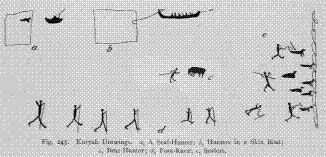
Fig.
245. Koryak Drawings. a, Seal-Hunter; b, Hunters in a Skin Boat; c, Bear-Hunter;
d, Foot-Race; e, Sealers.
on which there is a seal;
b represents
hunters in a large skin boat, who ar
pulling themselves up to an ice-floe by means of a hook; while engaged in
this, the hunters have ceased to row. c represents a hunter about
to attack
a bear with a spear, d represents a foot-race,
and here there seems to be
a suggestion of linear perspective, since the figures of the runners
become
larger from right to left, e
represents a group of hunters who are thrusting
their harpoons at seals which they have come across on the beach at low
tide; the seals are hastening to get back into the water. The line represents
the edge of the water, and the zigzags indicate the waves on the beach.
Here, as in the other drawings, we have, in the absence of
perspective,
thearrangement of one object above the other. One of the hunters is represented
falling to the ground during the quick
run.
Fig. 246 represents
two subjects. In a, several hunters in kayaks are
pursuing a seal on
a shallow beach; the seal cannot dive,
but glides along
726
JOCHELSON, THE
KORYAK.
on the water, disturbing its surface. In
b we have a fisherman
with a hand-net, standing in
the water.1
Fig.
247 represents three phases of the whale-hunt. In the first attack
(a)
the
oarsmen are rowing with all their might to get near the spouting
whale;
the harpooneer, in the bow of the skin boat, being shown in the act of
thrusting
his harpoon. The
second drawing (6) shows the whale struck by a

Fig.
246. Koryak Drawing. a, Sealers; b, Fisherman with Net.
harpoon and by a spear; but it is still dragging the
boat and the hunters
with
great force, creating a current in the water. In the final situation (c) three skin boats,
tied to one another by thong lines, are towing the captured whale.

Fig.
247. Koryak Drawing. representing Whaling- Scenes
It is interesting to note that the last boat is going
stern forward, evidently
in
order to give the bow, by which the
whale is towed, the proper direction.
I gave to an artist in Kamenskoye three pencils
black, red, and
blue
to see how he would use the colors in his drawings. In most cases
he
used the colors correctly, following the colors of the objects which he
represented.
In illustrating the interior of the house, for instance, he drew
the
enamelled teakettle on the fire with the blue pencil, the flame with the red,
and the smoke rising from the fire with the black pencil. Another of
his
drawings represented the carcass of a skinned sacrificial dog that had been
left in the tundra, being torn by crows. The carcass was colored red,
and
with such fine shadings that the rounded muscles of the skinned animal
could
be seen. The crows were entirely black. In the figures of dogs he
made
their protruding tongues red, and in those of seals he made the eyes red.
However, in some drawings he used the colors in a most fanciful manner.
A
few words may be said as to
drawings of religious and mythological
1 See
p. 530.
727
JOCHELSON,
THE KORYAK.
subjects. They do not in any way differ from
ordinary drawings, specimens
of
which are reproduced here. They have the same defects, and are also
realistic.
Somewhat fanciful is a drawing of the spider-crab, representing the
marine
deity.1 The drawings of circles around the heads of the Supreme
eity,
his wife and son,2 and the beams radiating from the heads of the
first two,
seem
to be an imitation of the circles and rays representing the halos around
the heads in orthodox icons, which the artist had no doubt seen in Russian
houses on
more than
one occasion on
his trips to Gishiginsk.
Writing.
Although I found no pictographic letters on bark among
the
Koryak, such as are found among the Yukaghir, and which serve
with
them as a means of communication between people at a distance,
yet
the memoranda and commercial notes used by the Koryak traders are
curious
specimens of a primitive writing of a somewhat pictographic nature.
The
Koryak traders in Kamenskoye and in northern Kamchatka purchase
from
Russian merchants pencils and paper or memorandum-books, in which
they
score their purchases and sales, denoting the articles by means of real-
istic or
conventionalized reproductions.
Figs.
248-250 represent three specimens of such records of Qaci'lqut, a
Koryak
trader of Kamenskoye. Fig. 248 represents a record in his memo-
randum-book
of goods received at a fair from the clerk of a Gishiginsk merchant
with
whom he keeps an open account. Fig. 249 is a copy of a letter con-
taining
a list of furs forwarded by Oaci'lqut to the merchant. Fig. 250 rep-
resents
a list of goods which he furnished me for our ethnographical collection.
The
system of records used by Oaci'lqut consists of a representation of
the
articles, in real or conventionalized form, on one side of a long line, and
of
special numeral signs on the other. Oaci'lqut, however, does not adhere to
one particular side in representing the articles or their number. The bill
which
he presented to me (Fig. 250) differs somewhat from his ordinary notes.
His
system of sign-figures puzzled me somewhat at first. To my question
as
to who invented them, Qaci'lqut replied, "I know myself." Later on I
found
in the archives of the natives on the Kolyma River receipts of Russian officials of the eighteenth and the beginning of the nineteenth centuries. The
receipts
testified as to the payment of tribute in furs by the native chiefs, and
the
number of fur skins or rubles received as tax was indicated by Russian
letters
and also by means of the system used by Oaci'lqut, evidently for the
benefit of the illiterate natives. It consisted of a simplification of the Roman
system of numeration, being reduced to three signs only,3 I (one),
X (ten),
and
X enclosed in a circle (one hundred), as in Fig. 249, 4. Such receipts
were
found also in the archives by Mr. Bogoras.
In one, dated 1823, given
1 See
Part I, Fig. I, p. 20.
2 Ibid., Figs. 40, 41, p. 93.
3 It is of interest to remember that
the ancient Egyptian numeration consisted of only four signs; namely,
for 1, 10, 100, and 1000. In composing large numbers, they were used in the same
manner as Qaci'lqut uses his
three signs, by means of repetition (see Tylor, Anthropology, London,
1904, p. 313).
92JESUP NORTH PACIFIC
EXPED., VOL.
VI., PART
2.
728
JOCHELSON, THE
KORYAK.
to the elder of the Omotski Yukaghir Clan by the
chief of the Kolyma district,
the
following signs were used: X (one ruble), [] (ten rubles), ® (a hundred rubles),
and I (kopeks). The use of the three signs by Qaèi'lqut can be ex-
plained
as an imitation of the old Russian signs by Oaci'lqut's ancestors. At
present
Russian officials do not use these signs in their receipts. Following
is
a more detailed explanation of the use of the three signs, based on the
statements
of Oaci'lqut himself.
|
Record
from Memorandum-Book (Fig. 248).
1.
One iron pot.
The pot is represented by a circle.
2.
Two tea-kettles. The tea-kettle is represented by a circle with a
beak, the
latter representing the spout. A little arc on the top stands
for
the handle.
3.
Twenty-five
pounds and a half of leaf-tobacco.
The tobacco is represented
by a bunch of leaves, and the fraction one-half is indicated
by a dot. This arithmetical sign I have not found in the receipts
of the tax-gatherers of the eighteenth century. It is Qaói'lqut's
own
invention.
4.
One large knife. The knife is represented by a long vertical line.
5.
Two small belt-knives. The knife
is represented by a
vertical line smaller
than the preceding one. In this memorandum, Qaci'lqut
has departed somewhat from his system by denoting the number 2
twice,
once graphically, and again by numerical signs.
6.
Twenty
pounds of wheat-flour. The
flour is indicated by a black ring, which
stands for a full bag of flour.
7.
Six
papers of needles. The
paper is indicated by a rectangle, which stands
for a paper filled with needles.
8.
Fifty
large needles. The
place for indicating the object is left blank, which
is equivalent to "ditto;" but under the numeral signs there
is a long horizontal line, which signifies that the needles are of a
larger
size.
9.
Calico
prints for one shirt. The
calico is represented by a horizontal line,
which stands for a strip of cloth cut off from a bolt of goods.
10.
One
woollen shawl.
The shawl
is represented
by a rectangle with fringe
on the sides.
11.
One
tablecloth. The tablecloth
is indicated in the same way as the shawl.
12.
One
scarf. The scarf is
represented by a horizontal line with a fringe at
the end.
13.
Three
arshins' of red
cloth for a shirt.2
The cloth, like the calico (No.
9), is represented by a horizontal but longer line. The color
of the cloth is left to be implied, since the outside shirt is made by
rich
Koryak only of red cloth
14.
Two
plates. The
plate is indicated by
a ring, but of a smaller size than that for the pot
(see
No 1).
|

Fig. 248. Koryak Account. |
1 An
arshin is equivalent to two feet and a third.
2 See p. 593
729
JOCHELSON,
THE KORYAK.
15.
Three
woollen shawls (see №. 10).
16.
Four
strings of beads.
The string
of beads is represented by a thread strung with beads, with
the ends tied together; but the beads in the drawing have a rather strange form.
17.
Two
brass chains
for women's
hair-dressing. It
is interesting
that the
links are
represented
by rings which do not pass through one another, but are joined by a line.
18.
Nine
little bells.
The bell
is represented by a
ring with a little tag above, which stands for
the handle of the bell.
19.
Three
iron dog-chains. The
chain is represented as in No. 17,
only of a larger size.
20.
One
belt.
21.
Three
large belts. The belt
is represented
by a
horizontal line
like the piece of calico
(No.
9) or of cloth (No. 13).
|
22.
Twenty
bricks of tea.
The brick of tea is indicated by a black
rectangle.
23.
Six
cups and
saucers. Of
two concentric circles, the one inside
represents the cup, and the outside the saucer.
24.
Sixteen
buttons. Strangely, the
buttons are represented, not by round dots, but by dashes. I
suppose that the eye
of the writer of the bill did not distinguish clearly
their
difference.
25.
One
axe. The
axe is represented rather conventionally by a
sign resembling the letter P.
26.
Three combs.
The comb is indicated
by a
rhomboidal figure, with dashes under
the base representing the teeth.
27.
Eleven
pounds of sugar. A
little figure, which is neither a square nor a ring,
represents a sawed piece of sugar.
28.
One
frying-pan. The
frying-pan is indicated by a ring and a
dash, the latter
representing the handle.
Copy
of a Letter (Fig. 249).
1.
Five
sables. Why
a sable is represented only by its hind-legs is not
clear.
2.
Twenty
spring fawn-skins.
The drawing represents a skin taken from a new-born fawn. The
side-lines represent
the head and the
feet.
3.
Five fox-skins.
The middle
line represents
the skin, and the side-lines the four
legs.
4.
A
hundred and fifty reindeer-fawn skins.
The whole rein-deer-skin is represented by a
rectangular figure, and the skin from the legs by four dashes. The difference in
the
representation
of the reindeer-skin and the fox-skin is due
to the fact that the fox-skin is taken off
entire, and is
round; while the skin of the reindeer,
before being taken off, is first cut, beginning at the lower lip, the
entire length of the animal. The
reindeer-
skin
is therefore shown opened.
5. Five
bear-skins. The
bear-skin is
taken off in the same manner as the
skin of a rein-deer, and
it is
therefore shown opened out. The paws are not indicated, being imma-
|

|
|
|
730
JOCHELSON, THE
KORYAK.
terial; but a more characteristic
feature of that animal is indicated on the skin, namely,
thick black
hair.
6.
Ten
wolf-skins. The
wolf-skin is taken off in the same manner as the reindeer-skin, and its
representation differs from that of the reindeer only by the addition
of a long tail.
7.
Two
wolverene-skins. The skin of the wolverene is taken off like that of the
fox. Accidentally it is represented as
smaller in size than the fox. Wolverenes in general are
larger than foxes; but the characteristic feature of that animal a
large body and
short legs is brought
out.
8.
Three
skins of polar foxes. The
skin of the polar fox is represented in the same way as that
of the other fox (No. 3).
9.
Ten
skins of polar
foxes for thirty rubles.
This memorandum, with a double meaning, since it indicates both the number of skins and their
cost, is put by Qaci'lqut
in parentheses (two lines). Of the number-signs, the former (ten)
indicates the number
of skins, and the latter (thirty) their value. The repetition of the fox-skin
signifies that
both numbers relate to the same
article.
10.
Three
coats of reindeer-skin. The illustration of the coat differs from
that of the reindeer-skin (No, 4) by having only two side-lines for
sleeves, and also by indicating the hood of the coat in the upper part.
11. Five
pairs of fur boots. Only
one boot is shown.
| List
of Goods (Fig. 250).
1.
A
boy's summer and winter suit
and travelling-overcoat (separately).
The suits are drawn, like the
coats, with the addition of boots
(under the line). In Fig. 250 Qaci'lqut did not use the numeral
sign in cases of single
articles.
2.
A man's winter and summer suit and overcoat.
Drawn as in No. 1.
3.
A girl's
summer and winter combination-garment and two overcoats.
In the drawing of the suit,
the woman's wide trousers are indicated.
4.
A
woman's summer and winter suit and two overcoats. Made as in No. 3, only of a larger size. The
lines between the first four num-
bers have no significance, and merely serve to separate one from
the
other.
5.
One
combination-dress of a child.
The peculiarity about this dress is that it has a flap sewed on
behind in the shape of a tail, which
is placed
between the legs.
6.
Two collars for reindeer-harness.
7.
Two reindeer
bridles and
reins. The
drawing of the bridle
differs
from that of the collar in having
inside the ring an indication of
the
hitching-strap; and on the side, of the bone piece.
8,
9. One reindeer-lasso, and a
coil of seal-skin thong.
10-12. A pair of boots, two reindeer-skins, one
whip.
|

|
|
Fig. 250. Koryak Account |
After
an examination of Qaci'lqut's writing, the interesting conclusion
may
be drawn that the conventional representation of animals and other
objects
of nature is not always a perversion of the original realistic represen-
tation.
Conventionalism in this case constitutes the primary phase. The
primary
conventionalization of
natural objects may be
the result of inability
731
JOCHELSON,
THE KORYAK.
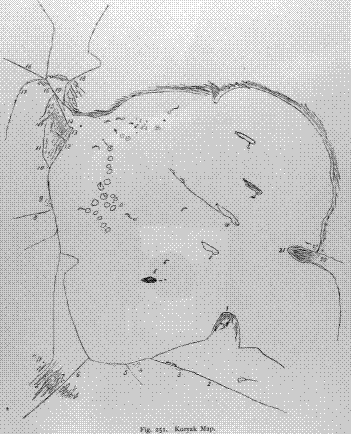
| 1.
Itkana
Cape.
|
8. Mikino River.
|
I5. Kamenskoye
Village.
|
| 2.
Paren River. |
9. Mikino Village.
|
16.
Penshina River.
|
| 3.
Paren (Poitin) Village.
|
10. Shestokova Village.
|
17. Oklan
River.
|
| 4.
Kuel Village. |
11. Shestokova or Ega'c
River. |
18. Talovka
River.
|
| 5. Kuel River.
|
12. Yagach Village.
|
19.
Talovka Village.
|
| 6.
Tilqai River.
|
13. Yarnochek Village.
|
20. Ma'mec
Village.
|
| 7.
Tilqai winter settlement.
|
14. Levati
Village. |
21.
Ma'mec Cape.
|
732
JOCHELSON, THE
KORYAK.
to
give a realistic
representation of objects, or, when the presentation is for practical
ends only,
a lack
of care
in execution.
In the present case, for instance,
it was important only that the illustration should serve to recall the objects.
With the exception of the
illustrations of dress (Fig. 250),
in which any
one would
recognize human
figures, we could not
tell the meaning of the
other primitive
illustrations in these writings without explanation.
Even other
Koryak to
whom I
showed the letter seldom
recognized all of them. Not
all Koryak
traders who
keep written
memoranda are familiar with the number-signs
used by
Oaci'lqut. One
of them, for instance,
used only one sign,
the line. He used
only units, in the same manner as
the Koryak and Chukchee
make use of counters in verifying
accounts.1
I
did not see among the Koryak notched sticks like those used by the
Yakut,
the Tungus, and the Yukaghir, in recording accounts. However, the
trader
mentioned employed some devices to
avoid the necessity of writing
an
interminable row of lines in enumerating large numbers; for instance, to
indicate
a pud (40 Russian pounds, or 36 pounds Avoirdupois), he drew a
balance
with loaded scale in equilibrium.
This signified full weight.
Nelson2 speaks of the trading-records
of the Alaskan Eskimo, which,
judging
by his account, are quite similar to those of the Koryak. Unfortu-
nately
he does not give any illustrations which would make it possible to compare
the records of the Eskimo and the Koryak.
Geographical Maps.
Among the Koryak pencil-drawings, there are also
geographical maps of the sea and the coast of Penshina Bay. The
Koryak
display in their charts quite a true perception of the relative disposi-
tion of the seacoast, rivers, mountains, and settlements. On the whole, their
charts
resemble very much the illustrations of Eskimo charts published by
other
travellers. The settlements are indicated on Koryak charts by rings,
dots,
or small dashes, which represent houses; small rivers are represented
by
one line, large ones by two parallel lines; mountains are represented by
parallel
shadings of different degrees. One chart made by a lad of seventeen
in
Kamenskoye, and representing the northern part of Penshina Bay, is
especially
well made (see Fig. 251). Itkana and Ma'mec Capes protrude
into
the bay, making it appear very narrow. As a matter of fact, this part
of the bay is very narrow (see Part I, map). In calm weather the passage from
the Itkana settlements to the Ma'mec can be made in a skin boat in
from
eight to ten hours. The mouth of the Penshina and Talovka Rivers,
which
empty into one inlet, the Kamenskoye and the Talovka settlements,
the
mountain-ridge between Talovka and Penshina, and a few other features,
are
also well drawn. The three Itkana villages are not indicated. In the
bay are shown some
hunting-scenes of floating ice-fields with seals on them, of spouting whales in pursuit of sea-mammals, and hunters in kayaks and
skin boats.
1 See p. 427.
2 See
Nelson, p. 198.






















